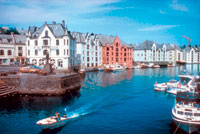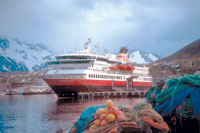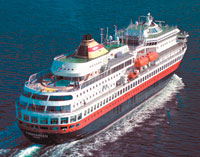| Gathering
by the door, we checked our watches and sprang ashore
as soon as the gangway was landed. Knowing we had only
30 minutes in port, we fanned out in all directions
to explore this small Norwegian village as quickly as
we could. After exactly 15 minutes of walking, we turned
around and started the return hike to the ship, confidently
arriving moments before the gangway was lifted. Soon
we were underway again, sailing up the Norwegian coast
for four hours before stopping at another port and repeating
the process all over again.
 |
Making
67 port calls in just 12 days, the Norwegian Coastal
Voyage is one of the most port intensive and culturally
rich cruises available. Known to Norwegians as the Hurtigruten,
or Coastal Express, it remains a unique sea voyage,
blending cruiseship comforts with cargo ship purpose
and aura. With a different ship sailing each day from
Bergen along the western shores of Norway to above the
North Cape and all the way to the Russian border and
back, the Hurtigruten has been a vital part of living
along the coast for over 110 years, shuttling not only
people but essential cargo and supplies between seaside
communities. Today,
the service is still used by the Norwegians like a bus
as they hop on and off between remote villages, sometimes
staying onboard only a few hours. The day-passengers
and the cargo carried are the underlying reasons for
the daily service and you'll find yourself sharing the
ship with a local family and their dog, a school group
out for an afternoon excursion or a bridal party- still
in their wedding gowns- celebrating en masse till the
next town. By sailing on the Hurtigruten, you are more
than taking a cruise-you are being integrated into a
culture and seeing one of last routes where sea travel
is part of daily life.
Known as "The World's Most Beautiful Voyage,"
it certainly did not disappoint on my mid-September
sailing which showed me far more of the country than
any conventional Norwegian fjords cruise could have.
We did hit the major tourist spots, including sailing
miles inland to the spectacular Geirangerfjord on a
warm, sunny day, with lush mountains towering thousands
of feet overhead and waterfalls dripping down on either
side. While we visited major ports like Trondheim, Alesund
and Hammerfest, we also explored narrow channels and
constantly skirted rocky outcroppings in the middle
of the night, and witnessed the jagged peaks of the
Lofoten Islands rising victoriously from the ocean. Later
on, we ventured into the tiny Trollfjord, where the
ship seemed barely able to turn around, and constantly
marveled at the small farming communities nestled in
tracts of land between the sea and the dramatic, grumpy
looking mountains towering above. In fact, Norway's
coast is so spectacular, so thrilling and so continuously
beautiful that even after 12 days of nonstop sightseeing,
you never become jaded from the scenery.
 |
As
we went further north, ultimately spending over half
the trip above the Arctic Circle, the green hills and
quaint villages gave way to a harsher Arctic climate
as mountains became blanketed with snow near the North
Cape. With winter approaching, the weather became a
bit more brutal, and we watched with interest as the
cargo operations carried on despite rain or snow. At
night, groups of us would huddle out on deck to watch
for the Northern Lights, with sightings that left us
in awe and sent others scurrying around the ship to
wake up fellow passengers who had already retired for
the night.
The full roundtrip voyage takes twelve days and calls
at 34 different ports while making 67 stops, with the
same ports being visited when heading northbound as
southbound. However, if you only go one way, you see
only half the story. A one-way voyage is certainly a
wonderful trip, but the full flavor of the coast and
the true bonding with the ship, the passengers and Norway
itself really occurs on the full roundtrip. With
the ship's transportation and cargo requirements dictating
the schedule, port calls are often limited to 30 minutes,
with only a few major ports offering longer stays. That
is part of the fun, however, as all of these small villages
can be explored on foot in short time and everyone relishes
these quick jaunts. Some made it a sport to try and
step foot in each port, and there was always a spirited
crowd waiting to go ashore even when the ship docked
as late as 11PM. This
does not mean, however, that passengers will be deprived
of a chance to go ashore on longer visits or explore
a bit further inland. A program of 18 shore excursions
has been developed, with some of them leaving the ship
in one port and rejoining the ship in another port later
in the day. Some are fairly conventional motorcoach
tours while others are a bit more exotic, including
bird watching safaris, dogsledding trips, and snowmobiling
and lasso-throwing with the Sami people. Note that during
the winter, the shore excursion program is more limited
with only 8 options. Food
is an important distinction between the Hurtigruten
and cruiseships-there is simply not the tremendous abundance
nor quality of food that you find on a normal cruise.
Breakfast and lunch are buffets with a good variety,
but with a strong focus on Norwegian food (i.e. an astounding
variety of seafood and fish.) Dinner is a fixed menu
of an appetizer, entrée and dessert. The menu
is posted during the day, so if the entree (which is
usually fish every other day) is not appealing, you
can ask for something different beforehand. The food
is hearty and good, but not gourmet, and a 24-hour café
not included in the cruise fare is available. During
the peak season, lunch and dinner are fixed tables with
two seatings.
 |
There
are now four different types of ships that operate on
the Hurtigruten, each offering a different style. The
three 650 berth "Millennium Class" may feature
balconies, swimming pools or saunas and are very similar
to smaller, modern cruiseships. The six "New"
ships accommodate approximately 460 passengers in a
slightly more intimate but still very modern and attractive
ship. Two "Mid-Generation" ships, however,
left me feeling cold, with neither the amenities nor
beauty of the newer ships nor the charm of the "Traditional"
ship. If possible, avoid sailing on the Mid-Generation
ships, although NCV does offer special "No Frills"
package rates for these ships for those looking to save
some money.
One Traditional ship, built in 1964, still sails on
the Hurtigruten during the off-season from September
to April and is the most authentic way to experience
Norway. Adorned in rich wood paneling and accommodating
a maximum of 170 passengers, the MS Lofoten has a log-cabin
coziness and, for some, is the only way to travel due
to its warm ambiance and old fashioned feel. Cabins
are tiny (some even without private facilities) but
the charm and atmosphere, including a significantly
smaller percentage of Americans, more than makes up
for it. If you can forgo cruiseship comforts like elevators
and balconies and want a bit more nautical environment,
sail this well maintained classic that is Norway's only
floating national historic monument before it- and a
link to the past- is retired.
With a recently lowered Norwegian government subsidy,
the Hurtigruten has been increasingly turning to tourism,
and they have even broadened their cruise program, now
sending a ship to Antarctica as well as offering adventure
cruises to Spitzenberg and the Lofoten Islands. To further
tourism, NCV has put together extensive pre- and post-cruise
packages ranging from a 14-day program featuring a few
days in both Iceland and Norway to multi-day excursions
in Lapland. The
summer season is the most popular, and consequently
crowded, as passengers come to see the Midnight Sun
and enjoy the relatively warm weather. The winter season
is an amazing chance to experience dramatic Arctic landscape,
but most shore side attractions will be closed and you
should expect some rough weather. Possibly the best
time to sail is the so-called shoulder season in September
and April. Here, the attractions are still open, but
the crowds are gone. (The North Cape typically gets
6,000 visitors a day during the summer- when I went
in mid September, we 35 passengers were the only ones
there.) The weather in the south is still warm, you
get the chance to see the start of the winter landscape
up north, and there is a fair chance of seeing the Northern
Lights. No
matter when you go, however, you'll be among the fortunate
few to experience this most memorable voyage and see
Norway the way it was meant to be seen. |